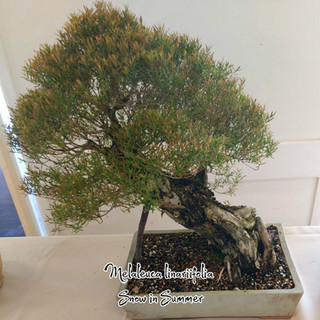Using Aussie Natives as Bonsai Specimens
- Jazz Carter

- Jan 22, 2022
- 3 min read
Updated: Jul 6, 2022
Bonsai is the technique of minaturising trees through careful culture and is a lengthy process but definitely worth it and a great thing to pass down to the next generation.
Recently I attended a Redlands Bonsai Society event that showcased Australian Natives that have been grown successfully and so beautifully into Bonsai specimens, even I was surprised at some of the different varieties used!
For many years Australian species were overlooked by many and exotic species were favoured, I believe that this was just because traditionally they had never been used and also because people did not think that natives could be trained into Bonsai.
However, it makes sense to use Australian native species, particularly for us in Australia. We live in a huge country with many different climates within it and by using natives we can choose plants that are locally endemic or others that we know will grow well where we are situated.
Reasons for choosing Australian Natives for Bonsai
Readily available
A lot of choice
Fast growing
Can repot all year round
Can be wired
Can be leaf and root pruned
Australian natives are beautiful with unique features
Eucalypts have gorgeous shedding bark
Some species are deciduous although most are evergreen
Grow well in our climate
There are so many Australian native plants worthy of turning into a Bonsai specimen and when doing so there are a few things to consider, outlined below.
Start with a good healthy plant, a bushy one if possible with lots of different options for branch selection
Choose a plant with a strong and prominent root system
A thick trunk is appealing
Small leaves, flowers and fruit are desirable traits - leaf size can be reduced though Bonsai culture although flowers and fruit cannot
Use a good cutting tool - Bonsai snips, secateurs
Remove lots of the tiny leaves and branches, leaving the major branches
Lift the plants canopy by taking small leaved off the main trunk
Remove half of the roots (and usually remove half the foliage)
Wire and bend branches into contorted gnarled shapes that simulate older age - it is best to imitate the natural form of the species selected
A few well known Australian Natives to consider
Acacia
Prune back hard in early Spring to reduce growth rate
Provide as much light as can be provided
Turn often to maintain even growth
Appreciate ample water and fertiliser when in active growth phase
Less water required in Winter, do not let them dry out completely
If it drop its leaves in Winter, keep barely moist until new growth starts in Spring
Brachychiton
A great choice for a beginner
When trunk reaches 50mm in diameter cut 25mm off the top of the pot and remove the same amount of soil, continue preocess once a month until you expose 100 - 150mm of strong taproots
Use pruning shears to cut the trunk back to the lower 3 branches, in Spring remove the plant from the pot and slice horizontally through the rootball, cutting away about half of the roots
Repot into a Bonsai Pot and keep warm and barely moist for 1 month while new roots form
Cut back any branches any time to create a bushy appearance
Grow in a sunny position and protect from sudden cold or draughts
Callistemon
Easy to grow and vigorous
Easy to propagate
Not suitable for Winter temperatures below 10 degrees Celcius
Grow in a sunny position, water and fertilise heavily in Summer but keep less moist in Winter
Prune hard after flowering
Eucalyptus
Evergreen trees
Easy to propagate
Fast growing
Thrive in any soils and most conditions
Great choice for a beginner
Very tough
Grow in full sun
Keep them pot bound as they can grow quite large very quickly
Water well in Spring to Autumn, less in Spring
Ficus
Easy to propagate
Great choice for a beginner
Interesting form and features
Aerial roots add another element
Many Australian native figs to choose from
Grow in full sun
Grevillea
Evergreen shrub or trees
Showy and interesting foliage
Unique flowers
Can tolerate some light shade
Fast growing
Can be cut back anytime
Melaleuca
Great for a beginner
Easy to propagate
Relatively pest free
Tolerates light shade
Easy to propagate
Trunks add interest with papery bark
Grow in full sun
Remember that Bonsai takes a lot of patience and dedication, it is a long term commitment, when you start with a seed or seedling and train it into your own desired shape it makes not only a beautiful plant specimen but also into a piece of art!
Happy growing!
#australiannativebonsai #bonsaiseeds #australianbonsai #usingaustraliannativesforbonsai #growyourownbonsai #Grevilleabonsai #melaleucabonsai #ficusbonsai #eucalyptusbonsai #callistemonbonsai #acaciabonsai #brachychitonbonsai #bonsaiseedsforsale #seedsforsale #bonsaiseedsforsale #seedsforbonsai #seeds #aussienativebonsai




















Comments